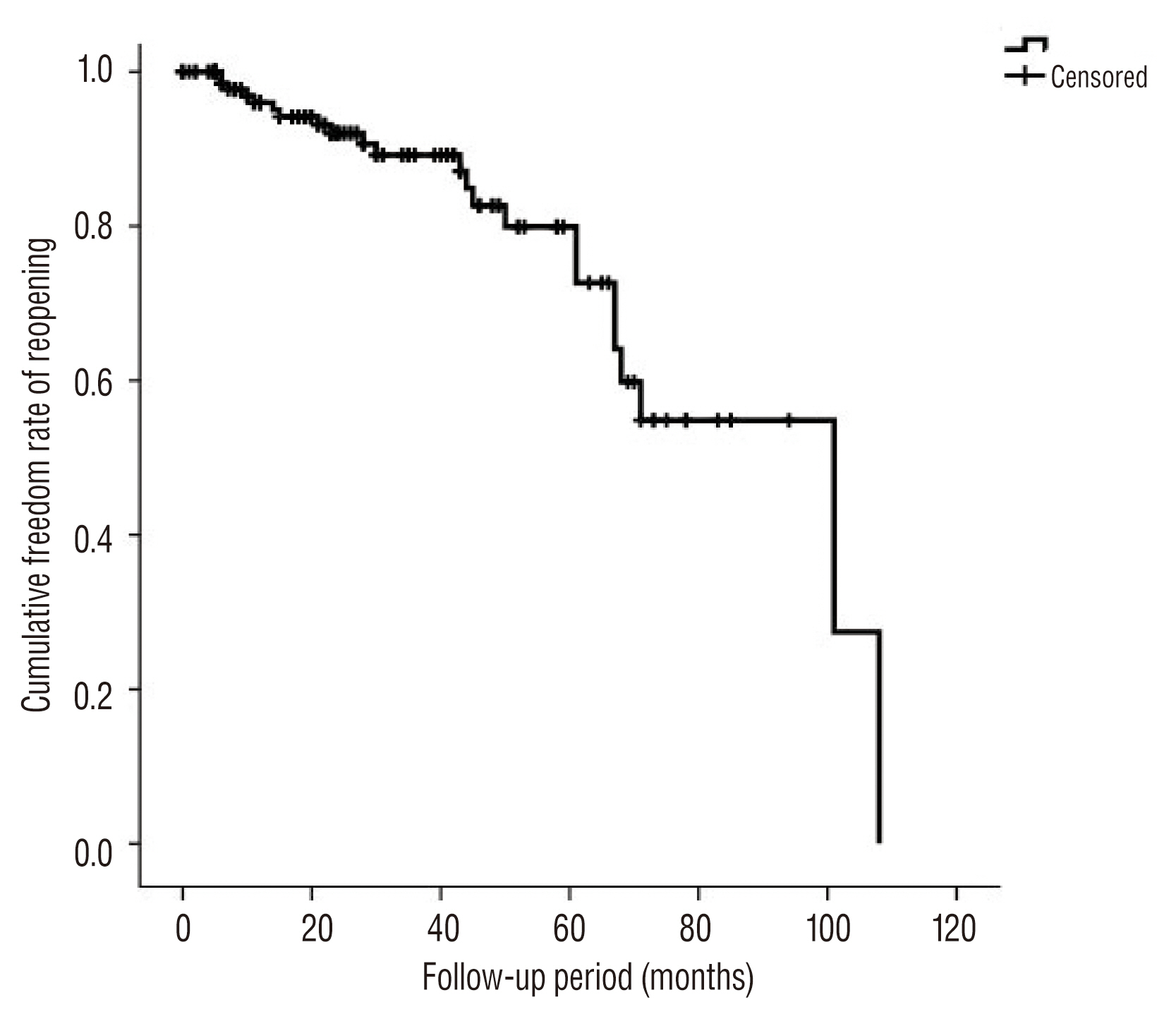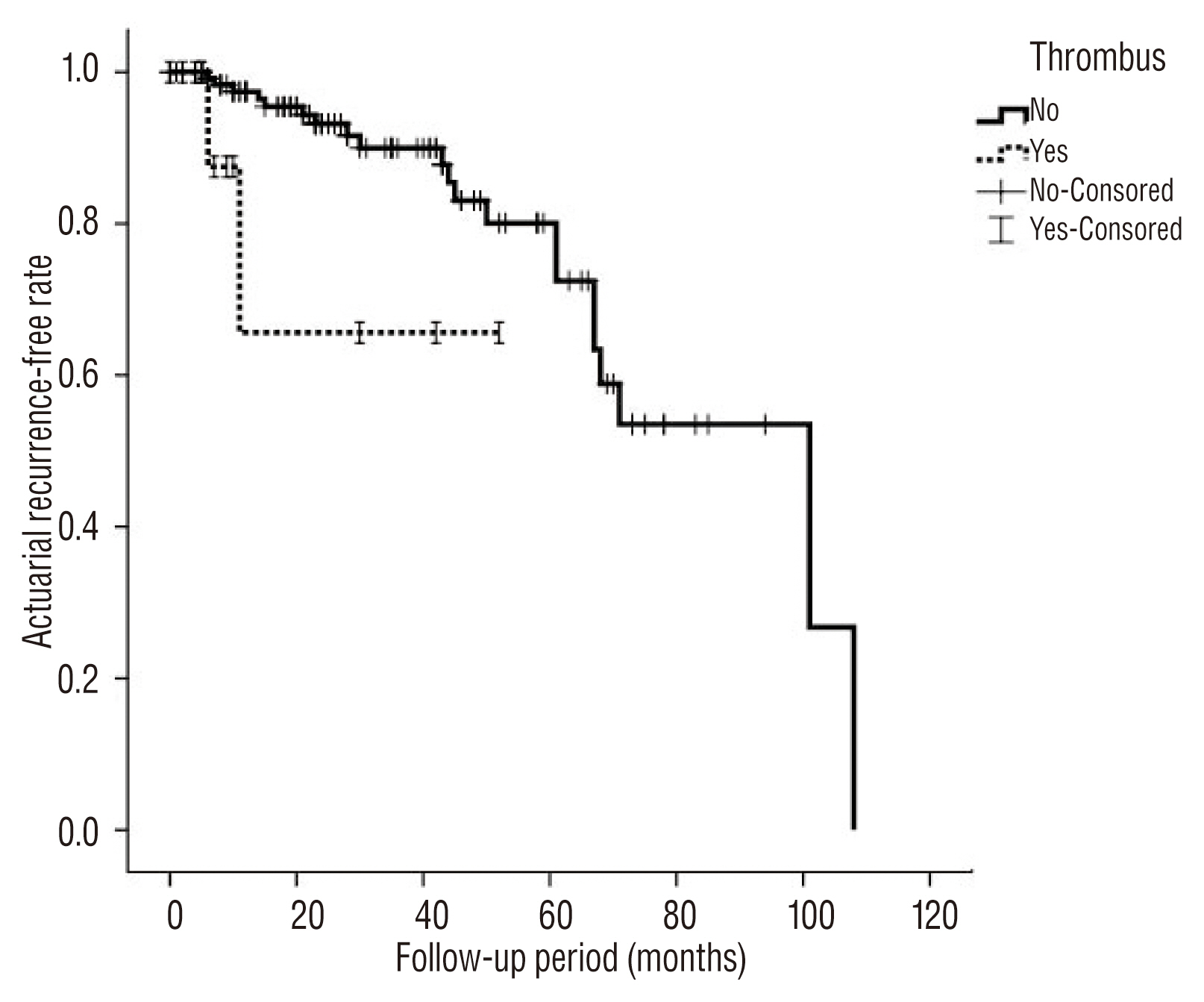J Korean Neurosurg Soc.
2018 Jan;61(1):19-27. 10.3340/jkns.2016.0101.018.
Treatment Outcomes with Selective Coil Embolization for Large or Giant Aneurysms : Prognostic Implications of Incomplete Occlusion
- Affiliations
-
- 1Department of Radiology, Samsung Medical Center, Sungkyunkwan University School of Medicine, Seoul, Korea. drpjeon@gmail.com
- 2Department of Neurosurgery, Samsung Medical Center, Sungkyunkwan University School of Medicine, Seoul, Korea.
- 3Department of Neurosurgery, Ewha Womans University School of Medicine, Mokdong Hospital, Seoul, Korea.
- KMID: 2403519
- DOI: http://doi.org/10.3340/jkns.2016.0101.018
Abstract
OBJECTIVE
The objectives of this study were to evaluate the immediate and long-term efficacy and safety of coil embolization for large or giant aneurysms.
METHODS
One hundred and fifty large or giant aneurysm cases treated with endovascular coil embolization between January 2005 and February 2014 at a single institute were included in this study. Medical records and imaging findings were reviewed. Statistical analysis was performed to evaluate prognostic factors associated with major recurrence (major recanalization or rupture) and delayed thromboembolism after selective coil embolization.
RESULTS
Procedure-related symptomatic complications occurred in five (3.3%) patients. The mean clinical and radiological follow-up periods were 38 months (range, 2-110) and 26 months (range, 6-108), respectively. During the follow-up period, the estimated recurrence rate was 4.6% per year. Multivariate analysis using Cox regression showed the degree of occlusion to be the only factor associated with recurrence (p=0.008, hazard ratio 3.15, 95% confidence interval 1.34-7.41). The patient's history of rupture in addition to the size and location of the aneurysm were not associated with recurrence in this study. Delayed infarction occurred in eight cases, and all were incompletely occluded.
CONCLUSION
Although immediate postprocedural safety profiles were reasonable, longterm results showed recanalization and thromboembolic events to occur continuously, especially in patients with incomplete occlusion. In addition, incomplete occlusion was associated with delayed thromboembolic complications. Patients with incomplete occlusions should be followed carefully for delayed recurrence or delayed thromboembolic events.
MeSH Terms
Figure
Cited by 2 articles
-
The Evolution of Flow-Diverting Stents for Cerebral Aneurysms; Historical Review, Modern Application, Complications, and Future Direction
Dong-Seong Shin, Christopher P. Carroll, Mohammed Elghareeb, Brian L. Hoh, Bum-Tae Kim
J Korean Neurosurg Soc. 2020;63(2):137-152. doi: 10.3340/jkns.2020.0034.Comparative Analysis of Feasibility of the Retrograde Suction Decompression Technique for Microsurgical Treatment of Large and Giant Internal Carotid Artery Aneurysms
Sunghan Kim, Keun Young Park, Joonho Chung, Yong Bae Kim, Jae Whan Lee, Seung Kon Huh
J Korean Neurosurg Soc. 2021;64(5):740-750. doi: 10.3340/jkns.2021.0066.
Reference
-
References
1. Bradac O, Hide S, Mendelow DA, Benes V. Aneurysm treatment in Europe 2010: an internet survey. Acta Neurochir (Wien). 154:971–978. discussion 977–978. 2012.
Article2. Brinjikji W, Kallmes DF, Kadirvel R. Mechanisms of healing in coiled intracranial aneurysms: a review of the literature. AJNR Am J Neuroradiol. 36:1216–1222. 2015.
Article3. Chalouhi N, Dumont AS, Hasan D, Tjoumakaris S, Gonzalez LF, Starke RM, et al. Is packing density important in stent-assisted coiling? Neurosurgery. 71:381–386. discussion 386–387. 2012.
Article4. Chalouhi N, Tjoumakaris S, Gonzalez LF, Dumont AS, Starke RM, Hasan D, et al. Coiling of large and giant aneurysms: complications and long-term results of 334 cases. AJNR Am J Neuroradiol. 35:546–552. 2014.
Article5. Dengler J, Maldanger N, Bijlenga P, Burkhardt JK, Graewe A, Guhl S, et al. Quantifying unruptured giant intracranial aneurysms by measuring diameter and volume--a comparative analysis of 69 cases. Acta Neurochir (Wien). 157:361–368. discussion 368. 2015.
Article6. Ferns SP, Sprengers ME, van Rooij WJ, Rinkel GJ, van Rijn JC, Bipat S, et al. Coiling of intracranial aneurysms: a systematic review on initial occlusion and reopening and retreatment rates. Stroke. 40:e523–e529. 2009.7. Gao X, Liang G, Li Z, Wei X, Cao P. A single-centre experience and follow-up of patients with endovascular coiling of large and giant intracranial aneurysms with parent artery preservation. J Clin Neurosci. 19:364–369. 2012.
Article8. Gerlach R, Beck J, Setzer M, Vatter H, Berkefeld J, Du Mesnil de Rochemont R, et al. Treatment related morbidity of unruptured intracranial aneurysms: results of a prospective single centre series with an interdisciplinary approach over a 6 year period (1999–2005). J Neurol Neurosurg Psychiatry. 78:864–871. 2007.
Article9. Heller R, Calnan DR, Lanfranchi M, Madan N, Malek AM. Incomplete stent apposition in Enterprise stent-mediated coiling of aneurysms: persistence over time and risk of delayed ischemic events. J Neurosurg. 118:1014–1022. 2013.
Article10. Huang MC, Baaj AA, Downes K, Youssef AS, Sauvageau E, van Loveren HR, et al. Paradoxical trends in the management of unruptured cerebral aneurysms in the United States: analysis of nationwide database over a 10-year period. Stroke. 42:1730–1735. 2011.
Article11. Hwang G, Jung C, Sheen SH, Park H, Kang HS, Lee SH, et al. Two-year follow-up of contrast stasis within the sac in unruptured aneurysm coil embolization: progressive thrombosis or enlargement? AJNR Am J Neuroradiol. 31:1929–1934. 2010.
Article12. Hwang G, Kim JG, Song KS, Lee YJ, Villavicencio JB, Suroto NS, et al. Delayed ischemic stroke after stent-assisted coil placement in cerebral aneurysm: characteristics and optimal duration of preventative dual antiplatelet therapy. Radiology. 273:194–201. 2014.
Article13. Kallmes DF, Fujiwara NH. New expandable hydrogel-platinum coil hybrid device for aneurysm embolization. AJNR Am J Neuroradiol. 23:1580–1588. 2002.14. Kim BM, Shin YS, Kim SH, Suh SH, Ihn YK, Kim DI, et al. Incidence and risk factors of recurrence after endovascular treatment of intracranial vertebrobasilar dissecting aneurysms. Stroke. 42:2425–2430. 2011.
Article15. Kim MS, Jo KI, Yeon JY, Kim JS, Kim KH, Jeon P, et al. Safety and efficacy of antiplatelet response assay and drug adjustment in coil embolization: a propensity score analysis. Neuroradiology. 58:1125–1134. 2016.
Article16. Lawson MF, Newman WC, Chi YY, Mocco JD, Hoh BL. Stent-associated flow remodeling causes further occlusion of incompletely coiled aneurysms. Neurosurgery. 69:598–603. discussion 603–604. 2011.
Article17. McDonald JS, Carter RE, Layton KF, Mocco J, Madigan JB, Tawk RG, et al. Interobserver variability in retreatment decisions of recurrent and residual aneurysms. AJNR Am J Neuroradiol. 34:1035–1039. 2013.
Article18. Molyneux AJ, Kerr RS, Birks J, Ramzi N, Yarnold J, Sneade M, et al. Risk of recurrent subarachnoid haemorrhage, death, or dependence and standardised mortality ratios after clipping or coiling of an intracranial aneurysm in the International Subarachnoid Aneurysm Trial (ISAT): long-term follow-up. Lancet Neurol. 8:427–433. 2009.
Article19. Peluso JP, van Rooij WJ, Sluzewski M, Beute GN. Coiling of basilar tip aneurysms: results in 154 consecutive patients with emphasis on recurrent haemorrhage and re-treatment during mid- and long-term follow-up. J Neurol Neurosurg Psychiatry. 79:706–711. 2008.
Article20. Piotin M, Blanc R, Spelle L, Mounayer C, Piantino R, Schmidt PJ, et al. Stent-assisted coiling of intracranial aneurysms: clinical and angiographic results in 216 consecutive aneurysms. Stroke. 41:110–115. 2010.21. Raymond J, Guilbert F, Weill A, Georganos SA, Juravsky L, Lambert A, et al. Long-term angiographic recurrences after selective endovascular treatment of aneurysms with detachable coils. Stroke. 34:1398–1403. 2003.
Article22. Raymond J, Klink R, Chagnon M, Barnwell SL, Evans AJ, Mocco J, et al. Patients prone to recurrence after endovascular treatment: periprocedural results of the PRET randomized trial on large and recurrent aneurysms. AJNR Am J Neuroradiol. 35:1667–1676. 2014.
Article23. Suzuki S, Kurata A, Yamada M, Iwamoto K, Nakahara K, Niki J, et al. Contrast stasis in large and giant internal carotid artery aneurysms as a good prognostic factor for endovascular coil embolization: retrospective study. Neurol Res. 33:832–834. 2011.
Article24. Turk AS 3rd, Martin RH, Fiorella D, Mocco J, Siddiqui A, Bonafe A. Flow diversion versus traditional endovascular coiling therapy: design of the prospective LARGE aneurysm randomized trial. AJNR Am J Neuroradiol. 35:1341–1345. 2014.
Article25. van Rooij WJ, Sprengers ME, Sluzewski M, Beute GN. Intracranial aneurysms that repeatedly reopen over time after coiling: imaging characteristics and treatment outcome. Neuroradiology. 49:343–349. 2007.
Article26. White PM, Lewis SC, Gholkar A, Sellar RJ, Nahser H, Cognard C, et al. Hydrogel-coated coils versus bare platinum coils for the endovascular treatment of intracranial aneurysms (HELPS): a randomised controlled trial. Lancet. 377:1655–1662. 2011.
Article27. Zhang Y, Li G, Cai Y, Zhu J, Huang S, Li T, et al. Rupture during the endovascular treatment of intracranial aneurysms: outcomes and technical aspects. Acta Neurochir (Wien). 155:569–577. 2013.
Article
- Full Text Links
- Actions
-
Cited
- CITED
-
- Close
- Share
- Similar articles
-
- Coil Embolization of Intracranial Aneurysms: The Effectiveness and Limitation
- Single-session Coil Embolization of Multiple Intracranial Aneurysms
- Recent Trends in the Treatment of Cerebral Aneurysms: Comparison between Endovascular Coil Embolization and Surgical Clipping
- Endovascular Coil Embolization of Very Small Intracranial Aneurysms
- The Stent-Assisted Coil-Jailing Technique Facilitates Efficient Embolization of Tiny Cerebral Aneurysms





